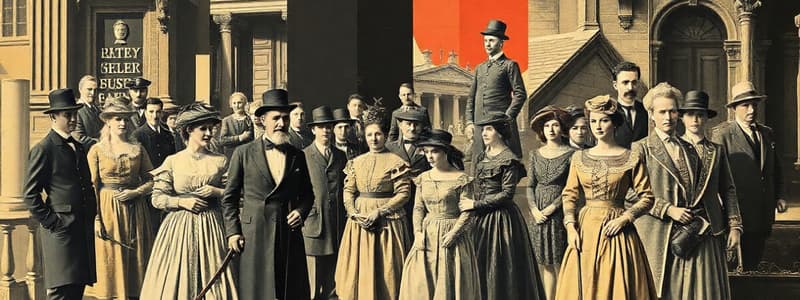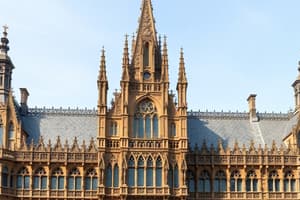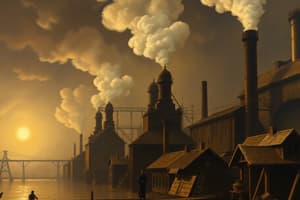Podcast
Questions and Answers
What characterized the upper class in mid-19th century Britain?
What characterized the upper class in mid-19th century Britain?
- Broad participation in labor
- Membership in the working class
- Inheriting land and wealth (correct)
- Reliance on industrial income
What was a significant change brought about by industrialization in the class system?
What was a significant change brought about by industrialization in the class system?
- Emergence of the upper middle class (correct)
- Reduction of regional divisions
- Decrease in the working class population
- Increased homogeneity among classes
Which statement best describes the working class by 1850?
Which statement best describes the working class by 1850?
- They were predominantly wealthy landowners.
- They had no influence on living standards.
- They made up a vast majority of the occupied population. (correct)
- They were exclusively composed of impoverished individuals.
What was a key difference between the northern and southern regions of the UK in the 19th century?
What was a key difference between the northern and southern regions of the UK in the 19th century?
What did Disraeli's concept of Britain being two nations emphasize?
What did Disraeli's concept of Britain being two nations emphasize?
What did the Crofter's War in 1882 signify?
What did the Crofter's War in 1882 signify?
What was a common trait of the middle class in mid-19th century Britain?
What was a common trait of the middle class in mid-19th century Britain?
How did the 1832 Reform Act affect the classes in Britain?
How did the 1832 Reform Act affect the classes in Britain?
What characterized the living standards of the working classes and the poor during the time of rising prosperity?
What characterized the living standards of the working classes and the poor during the time of rising prosperity?
Which social class primarily benefited from the period of unprecedented prosperity in Britain?
Which social class primarily benefited from the period of unprecedented prosperity in Britain?
What system did Gladstone introduce that aimed to provide financial security for workers laid off from their jobs?
What system did Gladstone introduce that aimed to provide financial security for workers laid off from their jobs?
What was a major challenge for working-class children during the mid-Victorian period?
What was a major challenge for working-class children during the mid-Victorian period?
What sentiment was often associated with poor relief and workhouses during this period?
What sentiment was often associated with poor relief and workhouses during this period?
What did official figures indicate regarding poverty levels after the introduction of the Poor Law Amendment Act 1834?
What did official figures indicate regarding poverty levels after the introduction of the Poor Law Amendment Act 1834?
Which of the following statements about the mid-Victorian boom is accurate?
Which of the following statements about the mid-Victorian boom is accurate?
What were some reasons that the living conditions for the working class remained poor?
What were some reasons that the living conditions for the working class remained poor?
Flashcards
Mid-Victorian Boom
Mid-Victorian Boom
A period of considerable economic prosperity in mid-19th century Britain, especially for the middle classes.
Working Class Poverty
Working Class Poverty
Even during prosperity, many workers faced poverty, unemployment, and poor living conditions.
Living Standards Rise
Living Standards Rise
Increased wealth and comfort for some segments of society after 1850.
Uneven Prosperity
Uneven Prosperity
Economic prosperity wasn't equally distributed; a large gap existed between the wealthy and the poor.
Signup and view all the flashcards
Limited State Intervention
Limited State Intervention
Governments' efforts to alleviate poverty were limited and often ineffective.
Signup and view all the flashcards
Poor Relief Stigma
Poor Relief Stigma
Assistance for the poor was often associated with shame and humiliation.
Signup and view all the flashcards
Post Office Savings Banks
Post Office Savings Banks
A government initiative to encourage saving among the working class.
Signup and view all the flashcards
Continuing Poverty
Continuing Poverty
Despite some improvements, poverty remained a significant problem even after economic growth.
Signup and view all the flashcards
Mid-19th Century British Class System
Mid-19th Century British Class System
A social hierarchy in Britain distinguished by wealth, occupation, and social status.
Signup and view all the flashcards
Aristocracy/Landowning Elite
Aristocracy/Landowning Elite
The highest social class, largely based on inherited land ownership and wealth in mid-19th-century Britain.
Signup and view all the flashcards
Middle Class
Middle Class
A broad social stratum comprised of merchants, manufacturers, professionals, and clerks in mid-19th-century Britain.
Signup and view all the flashcards
Working Class
Working Class
The largest social class in mid-19th-century Britain, comprising those who worked with their hands for wages.
Signup and view all the flashcards
Industrialization Impact
Industrialization Impact
Industrialization significantly altered the British social structure by creating a more powerful middle class.
Signup and view all the flashcards
Regional Division (UK)
Regional Division (UK)
Significant economic and social disparities existed among regions within the UK in mid-19th-century Britain, illustrated prominently by differences between industrial North and rural South.
Signup and view all the flashcards
Crofter's War
Crofter's War
A civil disobedience movement in the Highlands of Scotland in response to the uneven economic distribution, particularly between the industrial South and rural North.
Signup and view all the flashcards
Two Nations Concept
Two Nations Concept
A concept proposed by Disraeli suggesting the significant divide between the prosperity of some and poverty of others in mid-19th-century Britain.
Signup and view all the flashcardsStudy Notes
Class Division in Mid-19th Century Britain
- The class system was a prominent feature of mid-19th century Britain.
- People were categorized based on their social status and economic influence, particularly their relationship with work.
- A simplified view of the class system:
- Upper Class: The aristocracy and landowning elite.
- Middle Class: The largest class, encompassing merchants, manufacturers, professionals, and clerks.
- Lower Class (Working Class): Increasingly defined as those who labored with their hands. After the 1832 Reform Act, the working class's desire to challenge the upper landed gentry increased.
Upper and Middle Classes
- The upper class relied heavily on inherited wealth, primarily land.
- Despite representing a small portion of the population, their influence was immense.
- Industrialization significantly altered the social structure.
- A more financially successful middle class emerged, evolving into an upper middle class.
- Political progress for the middle class was gradual.
- Both upper and middle classes lacked homogeneity.
Working Classes
- By 1850, 4/5 of the population could be considered the working class.
- The working class also lacked significant homogeneity.
- The definition did not encompass "the poor", but rather those who worked with their hands to support themselves.
- The working classes saw improvements in real incomes and living standards.
Regional Divisions
- England dominated the social, economic, and political landscape of the United Kingdom.
- Regional divisions existed based on economic and social lines.
- The industrial north contrasted with the largely rural south.
- Even transportation infrastructure, like railways, failed to connect remote areas like the Scottish highlands to industrial centers.
- Gaelic speakers in Scotland were negatively affected by the increasing industrialization in the rest of the country.
Prosperity and Poverty
- Britain experienced unprecedented prosperity.
- Entrepreneurial spirit drove profits from industry and trade, impacting the middle class.
- Middle-class families saw improvements in their quality of life in living accommodations, education of children, and healthcare.
- Despite prosperity, poverty persisted and was concentrated among the working classes.
- The working classes experienced fluctuations in wages, impacted by the state of the economy.
- The gap between the rich and poor—a 2-nation concept, highlighted in the novels of Disraeli— remained significant.
- Improvements in wages, and falling prices, improved working class living conditions.
Poverty
- Mid-Victorian prosperity did not eliminate poverty.
- Issues like unemployment, poor living conditions (slums), and lack of education persisted.
- Child labor was common in unregulated industries.
Studying That Suits You
Use AI to generate personalized quizzes and flashcards to suit your learning preferences.




